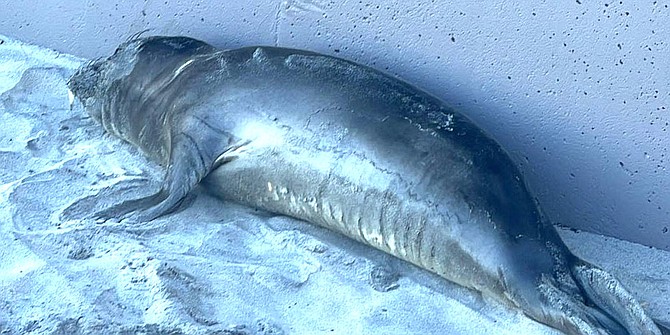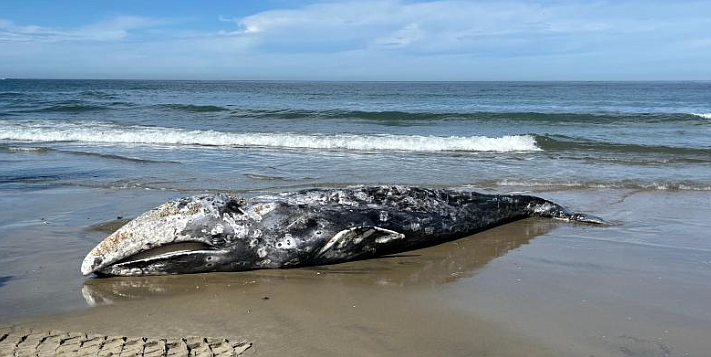 Facebook
Facebook
 X
X
 Instagram
Instagram
 TikTok
TikTok
 Youtube
Youtube

On March 19, Cristbel Adams was shaken to see a sea lion lying motionless in the sand by the Imperial Beach Pier. Since the December and January countywide floods, animals near the Tijuana River Valley and beyond have been dying, getting sick, or being displaced.
Adams blames the trash and sewage flowing into the U.S. for the the sick or dead animals.
"A lot of trash is coming from the dirty Tijuana River. The pollution got worse after the rainy season. I saw people collecting trash at the beach here last weekend.
On January 23, Imperial Beach Mayor Paloma Aguirre posted a video on Facebook as she stood at the Tijuana River Valley. "This is what we were left with after yesterday's storms: plastics, trash, styrofoam," she said. "It was all carried by the rains, and this is all making its way to the ocean. So we are not only being polluted by sewage but also trash."

Most sewage flows through the Tijuana River Valley, starting in Mexico. Then, additional untreated sewage enters the U.S. through ravines and canyons that feed the river leading onto the U.S. side of the border.
Around the same time in January, Adams strolled by the river valley area and "saw a bunch of dead birds ..... it’s really sad."
Sea life and wildlife eat plastic or styrofoam because of the stuck-on leftover food particles. Once the plastic or styrofoam is swallowed, the animals can choke, or the pieces can damage their digestive systems.
In another statement, Mayor Aguirre blamed the dead animals on "sepsis caused by specific types of bacteria that are traced back to sewage-contaminated water." The San Diego and Tijuana storms in January sent more than 14.5 billion gallons of untreated raw sewage into California from Mexico, according to the International Boundary and Water Commission.
On February 22, four days after World Whale Day, the National Oceanic and Atmospheric Administration was beckoned to help a 24-foot gray whale stranded at the La Jolla Shores beach — per their press release. The whale, which weighed about 11,000 pounds, died later that evening.

While no update was released on how the 1-2-year-old whale died, local surfers on Facebook speculated it could've been something the whale ingested, citing a Reddit post titled "An unusually high number of whales are washing up on U.S. beaches." On the 2023 Reddit post, the second highest upvoted (166 total) response reads, "And the bulk of them are dying from marine garbage in their guts. It’s not some bewildering mystery. We’ve destroyed the ocean and everything in it."
Fish, dolphins, sea turtles, and seabirds are also killed by plastic, warns worldwildlife.org. "Even microplastics—tiny plastic particles less than 5 mm in size and the most abundant debris floating in the marine environment—have been found in whales and their prey," says the wildlife site. "But their impacts are very different. This micro-pollution can break down from sunlight and other environmental factors into its invisible toxic chemical compounds."
Other animals were affected by the floods and sewage at the border.
Before and on February 29, the Tijuana River Valley Equestrian Association evacuated their horses as the nearby storm drains backed up. Sewage water, debris, and stench flooded the valley campgrounds and stables. "It hasn't stopped flowing yet," said a spokesman for the horse group. This campground was built here because it was 'above the flood plain'... but the flooding came from a second broken berm in Smugglers Gulch, on the west side of the City of San Diego stormwater ditch."
Over the recent weekend, Daniel H. warned his IB neighbors on Facebook, "BEWARE! It’s warming up, and these rattlers (rattlesnakes) are testing where they can get sun! A beautiful blue-sided boy I found in the TJ Estuary today."
In Imperial Beach and up in Valley Center, locals on Facebook forums said there were more rattlesnake sightings than usual after the heavy rains in December and January.
"Rapidly rising flood water from heavy rain can displace wildlife, including rattlesnakes," Rattlesnake Solutions rescue told Newsweek in January. "This can mean that in some areas, there will be a temporary increase of the likelihood of random encounters."


On March 19, Cristbel Adams was shaken to see a sea lion lying motionless in the sand by the Imperial Beach Pier. Since the December and January countywide floods, animals near the Tijuana River Valley and beyond have been dying, getting sick, or being displaced.
Adams blames the trash and sewage flowing into the U.S. for the the sick or dead animals.
"A lot of trash is coming from the dirty Tijuana River. The pollution got worse after the rainy season. I saw people collecting trash at the beach here last weekend.
On January 23, Imperial Beach Mayor Paloma Aguirre posted a video on Facebook as she stood at the Tijuana River Valley. "This is what we were left with after yesterday's storms: plastics, trash, styrofoam," she said. "It was all carried by the rains, and this is all making its way to the ocean. So we are not only being polluted by sewage but also trash."

Most sewage flows through the Tijuana River Valley, starting in Mexico. Then, additional untreated sewage enters the U.S. through ravines and canyons that feed the river leading onto the U.S. side of the border.
Around the same time in January, Adams strolled by the river valley area and "saw a bunch of dead birds ..... it’s really sad."
Sea life and wildlife eat plastic or styrofoam because of the stuck-on leftover food particles. Once the plastic or styrofoam is swallowed, the animals can choke, or the pieces can damage their digestive systems.
In another statement, Mayor Aguirre blamed the dead animals on "sepsis caused by specific types of bacteria that are traced back to sewage-contaminated water." The San Diego and Tijuana storms in January sent more than 14.5 billion gallons of untreated raw sewage into California from Mexico, according to the International Boundary and Water Commission.
On February 22, four days after World Whale Day, the National Oceanic and Atmospheric Administration was beckoned to help a 24-foot gray whale stranded at the La Jolla Shores beach — per their press release. The whale, which weighed about 11,000 pounds, died later that evening.

While no update was released on how the 1-2-year-old whale died, local surfers on Facebook speculated it could've been something the whale ingested, citing a Reddit post titled "An unusually high number of whales are washing up on U.S. beaches." On the 2023 Reddit post, the second highest upvoted (166 total) response reads, "And the bulk of them are dying from marine garbage in their guts. It’s not some bewildering mystery. We’ve destroyed the ocean and everything in it."
Fish, dolphins, sea turtles, and seabirds are also killed by plastic, warns worldwildlife.org. "Even microplastics—tiny plastic particles less than 5 mm in size and the most abundant debris floating in the marine environment—have been found in whales and their prey," says the wildlife site. "But their impacts are very different. This micro-pollution can break down from sunlight and other environmental factors into its invisible toxic chemical compounds."
Other animals were affected by the floods and sewage at the border.
Before and on February 29, the Tijuana River Valley Equestrian Association evacuated their horses as the nearby storm drains backed up. Sewage water, debris, and stench flooded the valley campgrounds and stables. "It hasn't stopped flowing yet," said a spokesman for the horse group. This campground was built here because it was 'above the flood plain'... but the flooding came from a second broken berm in Smugglers Gulch, on the west side of the City of San Diego stormwater ditch."
Over the recent weekend, Daniel H. warned his IB neighbors on Facebook, "BEWARE! It’s warming up, and these rattlers (rattlesnakes) are testing where they can get sun! A beautiful blue-sided boy I found in the TJ Estuary today."
In Imperial Beach and up in Valley Center, locals on Facebook forums said there were more rattlesnake sightings than usual after the heavy rains in December and January.
"Rapidly rising flood water from heavy rain can displace wildlife, including rattlesnakes," Rattlesnake Solutions rescue told Newsweek in January. "This can mean that in some areas, there will be a temporary increase of the likelihood of random encounters."